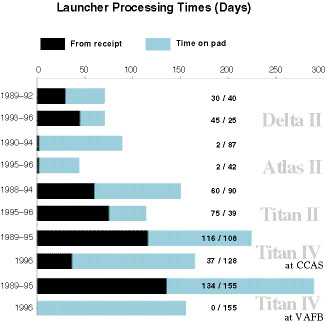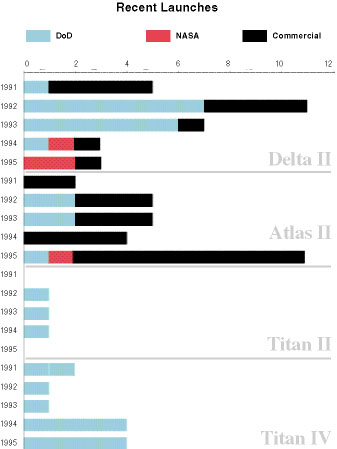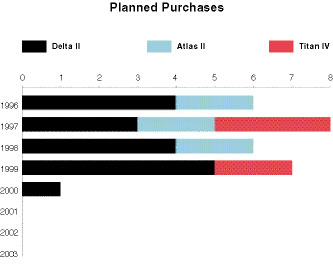In 1982, the US had ninety percent of the world’s space-launch market, but by 1992 that figure had dropped to thirty percent as the European Space Agency’s Arianespace began to take hold in the global marketplace. Other countries also offered “economy” launches of their own.
Cost and efficiency were the driving factors in this realignment. Arianespace provided launches at far lower cost and with a reduced cycle time and fewer employees. The US launch industry, with origins in 1950s-era intercontinental ballistic missile systems, featured long delays and manpower-intensive operations, leading to high cost and unhappy customers.
 The Defense Department’s 1994 Space-Launch Modernization Plan criticized the delays and lack of responsiveness, noting the impact on DoD and commercial customers. That same year, Air Force Secretary Sheila E. Widnall announced a drive for more routine and affordable space-launch operations.
The Defense Department’s 1994 Space-Launch Modernization Plan criticized the delays and lack of responsiveness, noting the impact on DoD and commercial customers. That same year, Air Force Secretary Sheila E. Widnall announced a drive for more routine and affordable space-launch operations.
The effort seems to be paying off for the Air Force. For one thing, USAF and the aerospace industry have managed to drive down the costs and cut the processing times on today’s launch systems. Some cycle times have been slashed by more than fifty percent.
In addition, they are optimistic about the success of the latest effort to produce a new expendable launch vehicle (ELV), saying that the program will pay for itself by 2010. Moreover, they said that the product of the Evolved Expendable Launch Vehicle (EELV) program will help revive the US commercial launch business.
The Defense Department expects that the EELV program will mark the first serious modernization of the nation’s launch vehicles and lead to reduced costs. However, until the EELV medium- and heavy-lift versions come on line, the Air Force must continue to use its older ICBM-based booster force.
Improving Medium, Heavy Lift
The Air Force and industry are, in fact, streamlining and improving operation of today’s fleet, said Col. Tommy Brazie, head of the Space and Missile Systems Center’s Launch Programs System Program Office (SPO). He said that SMSC is “driving with our [Air Force] Space Command partners to normalize [launch] operations.”
The emphasis has been on reducing time on the pad for the USAF medium-lift boosters–Delta II, Titan II, and Atlas II. The Air Force has improved efficiency and reduced cost by conducting more of its vehicle processing at the contractor plant and launch facility before placing the booster on the pad–so-called “clean vehicle” processing.
This change is illustrated in the chart above right. Time on the pad for Delta II boosters has dropped from forty days in 1989 to twenty-five in 1993. In 1988, Titan II processing took 150 days–sixty at the facility and ninety on the pad. That total has been cut by thirty-six days. Atlas II has shown even greater improvements, shaving forty-five days from its overall processing time, all from on-pad time. Colonel Brazie projects that on-pad processing for Atlas II will fall by another seven days this year.
The Colonel noted that other efficiencies and savings have come from the synergy among DoD, NASA, and industry. The Atlas and Delta programs in particular have benefited from advances in the commercial launch arena. Likewise, DoD’s Atlas Reliability Enhancement Program has produced valuable advances that have been transferred to the commercial sector.
The Titan IV is the nation’s only heavy-lift ELV. It bucks the general proposition that the less time on the pad the better. Colonel Brazie said that performing tests off the pad and then repeating the same tests on the pad was neither necessary nor cost-effective. “We chose to eliminate the off-pad testing instead of on-pad [testing], so we could test the vehicle in the stacked and ready-to-go configuration,” he said.
Titan IV has different processing requirements, which depend on its launch location–Cape Canaveral AS, Fla., or Vandenberg AFB, Calif. (See chart above.)
Historically, preparation for Titan IV launches at the Cape took an average of 224 days–116 at the facility and 108 on the pad. Now, processing takes 165 days, a reduction of 26.3 percent in overall cycle time.
 At Vandenberg, processing historically has averaged 289 days, with 155 spent on the pad. Today, that time has been cut 134 days, down to only the 155 needed on the pad. Colonel Brazie noted that the difference in processing times between the two facilities is primarily a result of Vandenberg’s use of a pad originally designed to launch space shuttles.
At Vandenberg, processing historically has averaged 289 days, with 155 spent on the pad. Today, that time has been cut 134 days, down to only the 155 needed on the pad. Colonel Brazie noted that the difference in processing times between the two facilities is primarily a result of Vandenberg’s use of a pad originally designed to launch space shuttles.
For the Titan IV, even more than for medium-lift vehicles, processing times vary greatly depending on the complexity of the payload or the particular satellite being launched.
The fact that current ELVs are tailored to meet specific payload requirements, rather than employing a standard payload interface, adds to cost and creates processing delays.
Maj. Gen. David L. Vesely, commander of Air Force Space Command’s 14th Air Force, oversees launch operations on both coasts. He likened the current process to changing the engines on a cargo aircraft each time it’s loaded or unloaded. The General noted that, with the new EELV, satellites should have a standard interface with the booster, “like putting [cargo] pallets on an airlifter.”
Some standardization for payloads is already in the works for the latest version of the Titan heavy-lift booster. The Titan IVB will employ mission-unique kits, providing a standard interface for payloads to permit launch-site processing.
The configuration will be the same as for the Titan IVA from the bottom of the rocket to the top of the payload interface skirt. From there up, the Titan IVB will be able to be customized on the pad.
“Should we have to swap payloads, there is reduced schedule impact–we save three months and have reduced cost–about $5 million per vehicle,” said Colonel Brazie.
He said that other improvements to the B model include “heroic” measures, such as changing the entire electrical system on the booster core. The new system, which is simpler and more easily checked out, uses up-to-date commercial parts and should “drastically reduce processing times.” A new ground system also uses commercial software and hardware instead of the “hodgepodge” system of the A model. The Colonel said the new ground system provides better data earlier, adding that it is much easier and less expensive to maintain.
The Titan IVB will have twenty-five percent increased performance from its upgraded solid rocket motors. The new SRMs will feature three segments instead of the current seven-segment version and will be checked out before they are mated to the core, not on the pad.
USAF plans to launch the first Titan IVB from Cape Canaveral in Fiscal 1997 and from Vandenberg in Fiscal 1999.
Colonel Brazie said the Air Force and Lockheed Martin, the prime contractor for Titan IV, continue to seek further improvements. Telemetry and data lines now run from the launch facility to Denver. The technicians can work from home, saving travel costs and allowing them to be more productive if weather delays occur, he continued.
New SPO, New Thinking
In 1995, the Air Force began a concerted effort to reduce the cost of spacelift. Secretary Widnall said the Air Force has “officially ended the study phase of improving our space-launch situation, and we’re aggressively pursuing the action phase.”
In addition to simplifying its procedures and reducing costs to commercial users, the Air Force increased commercial access to Atlas and Delta launchpads on a “noninterference” basis.
Traditionally, military launches have outnumbered commercial launches. In 1994, the split changed to fifty-fifty, and in 1995, commercial launches surpassed military launches. The number of commercial and civil launches is projected to exceed the number of military launches for the next few years.
The Air Force has also been upgrading its launch facility infrastructure under the Range Standardization and Automation program. AFSPC has invested heavily and plans to continue to do so for a few more years.
Interim standardization measures, said General Vesely, also include working with all key players to revamp the space-launch scheduling process, to establish quarterly launch reviews, and to strictly adhere to launch windows.
“There’s no quick fix, but we’re seeing results with our standardization efforts,” he said.
Another streamlining move was creation of Colonel Brazie’s launch-program SPO. The new SPO brings current launch vehicles under one management. The Air Force expects the new launch SPO to reduce overhead costs and foster synergy among launch programs.
Colonel Brazie said he plans to cut the size of the program office by forty percent by 1998, in line with USAF-wide acquisition reform measures. He has already reduced administrative, contracting, and budget staffs. Similar cuts are in store for technical staff, largely through such initiatives as combining engineering support for solid rocket motor boosters.
The SPO has already proven its capability in the latest Titan contracts, which highlighted recent changes in acquisition strategy. Working closely with the contractor in cost discussion, launch SPO personnel had the information to help them eliminate costly items of scant value.
Colonel Brazie added that the Air Force could shave costs another ten percent by combining Atlas and Titan crews, eliminating the need to keep full crews for each system at each launch facility.
Why the EELV
Notwithstanding these cost-saving endeavors and process improvements, US launch vehicles remain very expensive, the result of their ICBM-based technology, lack of commonality, and low production rates.
Most experts agree that the optimum solution is to employ a reusable launch vehicle (RLV) with “airplane-like” operation. NASA is pursuing that type of system for the long term, but the need for an improved ELV is urgent. During a decade of indecision, the US spent millions on unsuccessful programs, such as the Advanced Launch System, the National Launch System, and the Spacelifter.
 In 1995, the Pentagon initiated the EELV program. This program aims to produce systems that will eventually replace all of today’s medium- and heavy-lift launchers. Current plans call for first launch of a medium-lift EELV in 2001 and a heavy-lift EELV in 2005. Both would be based on a core system, a practice that the Defense Department hopes will lead to a cost-effective family of vehicles.
In 1995, the Pentagon initiated the EELV program. This program aims to produce systems that will eventually replace all of today’s medium- and heavy-lift launchers. Current plans call for first launch of a medium-lift EELV in 2001 and a heavy-lift EELV in 2005. Both would be based on a core system, a practice that the Defense Department hopes will lead to a cost-effective family of vehicles.
Secretary Widnall said the service is vigorously pursuing EELVs because the US needs “equally viable expendable and reusable launch vehicle efforts to cover our bets for the future.” She added, “I don’t want to repeat the mistake we made in the early 1980s of having all our eggs in one basket.”
The Air Force expects the EELV program to yield boosters that would produce savings of twenty-five to fifty percent compared with today’s models. It also expects the program to pay for itself in the 2007 to 2010 time frame, when the US could conceivably make the transition to a reusable launch vehicle.
The Defense Department did not opt for a completely new expendable launch system, said one Air Force official, because it saw “the promise of a reusable system that has higher cost savings” over the longer term.
“From a business standpoint,” he said, “it’s a smart investment because you get the payback in the investment that you made and then you have the opportunity to transition after that payback to an even more affordable system”an RLV.
DoD and Air Force officials state that the number one objective of the EELV program is to reduce cost for medium- and heavy-lift space vehicles. They plan to build a “system of systems” derived from existing technology and using commercial standards with minimum military specifications and paperwork.
The “system of systems” approach means both versions would use the same launch capabilities, infrastructure, ground support systems, and payload interfaces. In effect, an Air Force program official said, developing the EELV as a “family” with common elements will yield higher production rates (with lower costs) and reduce the numbers of launch crews, launchpads, and support facilities.
“All those things help to drive down the cost–the operations cost, as well as the manufacturing and hardware costs,” said the USAF official. “Overall, it would drive down the life-cycle cost of space launch.”
The program will take advantage of a recommendation to phase in new launch programs during satellite block changes to achieve greater savings. There are also acquisition risk-reduction phases or “exit points.”
In August 1995, USAF awarded four $30 million low-cost concept validation (LCCV) contracts. Alliant Techsystems, Boeing, Lockheed Martin, and McDonnell Douglas each have fifteen months to develop concepts to reduce cost. In keeping with the acquisition reform move, each contractor received only a one-page list of objectives, instead of a multiple-page statement of work.
The major product of the LCCV will be a life-cycle cost estimate (LCCE) with a confidence level of seventy percent. “This is really the heart of what you’re buying and evaluating–to see if you can really achieve the cost-savings goal the program is based on,” stated the USAF program official. The LCCV also provides such products as draft interface specifications, technology risk-mitigation demonstration results, and operation and support documentation.
In November, the Air Force will select two of the proposed concepts for the next phase–preengineering and manufacturing development. Each contractor will receive about $65 million. The seventeen-month pre-EMD phase will provide a greater level of detail, including defined manufacturing processes and final interface specifications. It also produces an updated LCCE at the eighty-five percent confidence level.
The final step is the EMD selection of one contractor, a move scheduled for the summer of 1998. The EMD phase will run for about eight years, leading to operational medium- and heavy-lift vehicles. USAF values the EMD contract at about $1.5 billion.
During EMD, the contractor will conduct low-risk payload flights: two for the medium-lift vehicle in the 20002001 time frame, and one for heavy lift in 2003. The contractor will also provide an updated LCCE at the ninety percent confidence level and activate operational facilities and support systems.
The Air Force expects to achieve initial operational capability (IOC) for the medium-launch vehicle in 2001 at Vandenberg and in 2002 at Cape Canaveral, and for the heavy-launch vehicle in 2005 at Vandenberg and in 2006 at the Cape.
The “Epitome”
The Air Force expects the EELV program to produce a commercial booster the military can use, or a military booster the commercial industry can use. Secretary Widnall called it the “epitome of dual-use technology.”
“Even though we are not specifically building in or buying commercial-unique requirements, the system . . . will benefit the nation from a commercial and international competitiveness standpoint,” stated a program official.
The one-page list of objectives highlights the fact that the EELV program will develop a spacelift system, “evolved from current launch vehicle systems or major subsystems thereof.” The four LCCV contractors plan to produce a concept based on current or previous work.
Alliant Techsystems states that it expects “to capitalize on the considerable investment and work that has gone into the two major space-launch advancements in recent years–the Solid Rocket Motor Upgrade developed by Alliant . . . and the European Ariane 5 cryogenic stage developed by Aerospatiale and Société Européenne de Propulsion.” Alliant has teamed with Arianespace, TRW, Aerojet, Allied–Signal Aerospace, and others for the project.
Boeing developed the inertial upper stage, used on the Titan IV, and has teamed with Rockwell, Bechtel, Thiokol, and others. The company will focus on “refining the system concept and lowering cost through commonality, simplicity, and the use of commercial practices.”
Lockheed Martin announced in November 1995 that it plans to develop a “common core” booster to achieve commonality across medium-, intermediate-, and heavy-lift vehicles. It expects to get leverage from its common-core strategy and its ongoing expertise in the launch business to develop a winning EELV concept.
McDonnell Douglas also plans to develop its current Delta II and new Delta III into a Delta IV family to meet requirements. The company states that its ongoing work, including a cryogenic upper stage, avionics suite, and automated launch processing control system, will provide “validation of the essential building blocks” for the EELV.
As part of the National Space Transportation Policy, announced in August 1994, the Clinton Administration gave primary responsibility for developing expendable launchers to the Defense Department. The principal responsibility for RLVs went to the civilian space agency, NASA.
NASA is working with industry first to develop a small, experimental RLV, the X-34, capable of lifting small satellites into orbit. It will be followed by a larger version, the X-33. Current plans do not anticipate IOC for the larger RLV until the 2010-15 period.
